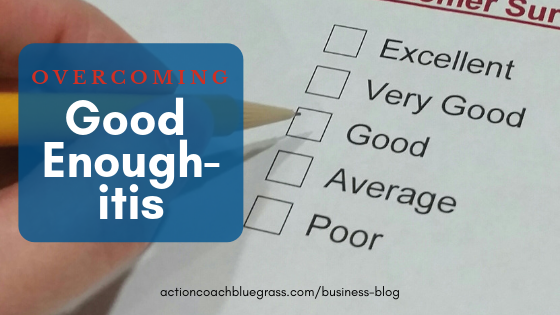[et_pb_section fb_built=”1″ _builder_version=”3.22″][et_pb_row _builder_version=”3.25″ background_size=”initial” background_position=”top_left” background_repeat=”repeat”][et_pb_column type=”4_4″ _builder_version=”3.25″ custom_padding=”|||” custom_padding__hover=”|||”][et_pb_text _builder_version=”4.4.2″ background_size=”initial” background_position=”top_left” background_repeat=”repeat”]
Many business owners find themselves in a similar place after a while – their business is doing pretty well and they are making a decent living, but there is something missing. They don’t feel as fulfilled at the office as they thought they would, and they feel like something is missing from the team. Everyone comes in, does their job, and takes pretty good care of the customers, yet the little things that would make it great never seem to get done unless you do them yourselves. When you begin to feel this, it most likely means you, your team, and your business have come down with a case of “Good Enough-itis”, where everyone performs just “good enough” to get by, but nobody excels.
What is needed in your business now is a focused effort to take every single team member’s performance up one notch. I refer to this critical business growth activity as creating a “Culture of Excellence”, and it is vitally important for getting you and your team out of the “good enough” phase that it is so easy to get stuck in. Excellence starts at the top, with focused leadership and dedication to the task being key to getting the improvements started and on their way to becoming part of the new culture.
In order to begin down the path to Excellence, the most obvious first step is to define what excellence looks like in your business or practice. We begin with looking at each department or function of your business, and asking ourselves what it means to be excellent in each area. The key to success in this exercise is to look at excellence from three different perspectives – the team, the customer/client/patient, and the business itself. Allocate time for your staff and their teams to spend a couple of hours defining what excellence looks like for their area. Get the ideas out of their heads and onto paper so that you can consolidate the inputs from every area and perspective. Be sure that your definitions of excellence are outcome based, as excellence must be measurable and monitored in quantitative terms.
Once you have the inputs gathered, it is time to begin creating action plans to implement as many of the ideas and suggestions for creating excellence as possible. Since you can’t work on all of them at once, identify the critical few to work on first – the areas where achieving excellence will have an immediate impact on your customers and/or business results. Establish a regular progress review process (project management excellence) to ensure that you are not just implementing the ideas, but that systems are developed to provide for training, testing and measuring of new initiatives, and accountability for results/outcomes. Make sure that the purpose of each activity involved in meeting your client’s needs is unambiguously defined, and that it is clear to everyone the difference between “good enough” results and excellent results. Review every process to ensure that they meet not just your customers’ needs, but also provide your team with everything they need to be excellent at their assignments, and the means to be recognized for their successes.
Excellence comes from all corners of your business, and can show up by accident/chance, or it can be part of your plan to take things to the next level. Look around your business every day as you walk it, finding excellence as it happens and encouraging others to seek it where it is lacking.
Author: Mark McNulty, Business Coach in Louisville, KY
[/et_pb_text][/et_pb_column][/et_pb_row][/et_pb_section]

